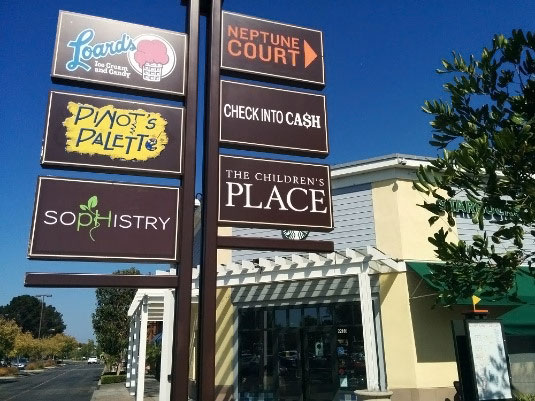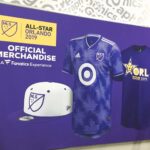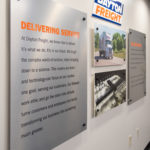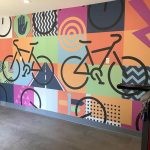
Indoor VS. Outdoor Wayfinding Signs
JANUARY 22, 2021|Categories
Outdoor SignsWhen people visit a business for the first time, they might feel a little anxious. They might be unsure how they’ll find the location or how they’ll make their way to the right room or area once they get inside the building. The last thing you need is for people wondering around not knowing where to go. Wayfinding signage steps in and helps people figurbee where to go. Wayfinding signs can also help put people at ease by showing them the way and providing them with the information they need to behave appropriately.
Indoor wayfinding signs and outdoor wayfinding signs provide guidance and improve the visitor experience. The type of signs you might use differs based on their location, though. The goals of outdoor and indoor directional signs are different.
WHAT ARE OUTDOOR WAYFINDING SIGNS?
Outdoor wayfinding signs can be used in many different ways. They can include outdoor signs placed at the entrance of a parking lot or on the lawn in front of a building or location. The entrance signs identify the building or business and provide direction to visitors arriving in a car, bike, or on foot. For example, an outdoor sign at the entrance to a parking lot or garage can tell drivers to continue straight, to turn left or right or to stop and take a ticket from the machine. An outdoor wayfinding sign on the lawn in front of a building or lot can identify the businesses located in the building and include arrows to direct visitors to the company or location they’re looking for.

Some examples of outdoor wayfinding signs include:
- Pylons: Pylons are large outdoor signs that usually list the names of businesses in a shopping center or office park. They help visitors determine if the company they are looking for is located in a particular shopping area or office complex. Due to their large size, pylons are easy to spot from a distance.
- Banners: Banners are usually attached to a building. They can feature the name or logo of a business and identify the occupant of a building.
- Monument signs: Monument signs are usually tall and skinny. They can identify a location or building, letting a person know if they are in the right spot. They can also serve as directional signs, complete with arrows that point people to their destinations.
- Digital signs: Digital signs can share information with passersby or help people find where they need to go. They are especially useful for changing information, such as limited time promotions or a pop-up store’s location.
- Maps: Maps might be the ultimate example of wayfinding or directional signs as they literally show people where places are in relation to each other. Maps help individuals figure out what turns to make and which direction to head to get where they want to go.
WHAT ARE INDOOR WAYFINDING SIGNS?
Indoor wayfinding signs guide people once they’re inside a building. They help people figure out where to go, identify areas and rooms and know the rules inside of a building. For example, having a indoor sign that says “No cellphones”. Indoor directional signs are often found in stores, shopping malls and airports. For example, when you visit a mall, there are usually signs with arrows pointing you in the direction of the anchor stores. Malls also usually have signs directing shoppers to the restrooms, security or customer service. Indoor wayfinding signs at hospitals or healthcare centers help people find the department they need, their loved one’s room, the gift shop or the restrooms.

Some examples of indoor wayfinding signs include:
- Directory signs: Many buildings will have a directory located near the stairs, elevators or front lobby. The directory usually lists the building occupants and includes the floor number or room number for them. Some directory signs also include a phone number for each occupant.
- Room plaques: A small plaque by the door of a room lets visitors know if they have found the right spot. Some room plaques list the room number or name and are permanent. Others can be changed based on who is using the room. A digital room plaque can allow for quick updates about the room’s use or identity.
- Floor and hallway markers: Signs placed on the walls of a building can identify the floor number and hallway name to help guide people to the different sections or areas of the building.
- Floor decals: In some cases, floor decals can act as wayfaring signage. The decals can trace a path for people to follow or be in the form of giant arrows that point visitors in the right direction.
- Instructional signs: Some indoor wayfinding signs are for informational purposes. They give people an idea of what’s allowed and where they can go. Instructional signs might tell people not to smoke, let them know a room is off-limits or ask them to wear a mask, shoes or shirt.
BENEFITS OF WAYFINDING SIGNAGE
An immediate benefit of wayfinding signage, whether it’s indoors or outdoors, is that it helps people know where to go. When visitors know where they are headed, they are more likely to feel at ease and less anxious about their visit. Putting people at ease is important in high-tension or high-stakes locations, such as hospitals. When people’s emotions are running high, creating a signage system that helps ease their minds can make them feel safe and secure.
DIFFERENCES BETWEEN INDOOR AND OUTDOOR DIRECTIONAL SIGNS
Indoor and outdoor signs differ in several ways. Although the signs can share the same goals and serve a similar purpose whether they are indoors or outdoors, the construction of the signs is often notably different.
Outdoor wayfinding signs are usually:
- Large: Depending on the type of sign, outdoor directional signs can be quite massive. Pylons and entrance signs need to be visible to drivers from a considerable distance away. They also need to be large enough for people to read easily, even if they are driving by at a quick speed.
- High-contrast: The colors used on outdoor signs should be high contrast so a person who’s moving quickly or far away can decipher the words and meaning of the sign.
- Made of weather-resistant materials: Outdoor signs need to be made from materials that can stand up to wind and rain and handle temperature swings from hot to cold, rain, snow or shine.
Indoor signs can be made from more delicate materials, such as wood or paperboard. Often, they are smaller than outdoor versions. Outdoor signs need to visible from far and wide, which often mean a bigger sign.
Although there are differences between indoor and outdoor wayfaring signs, the two often complement each other. The colors used on a pylon might match the colors used on a directory sign or room plaque, for example. The logos and branding on the signs should coordinate, whether they are located outside of a building or inside.
TURN TO SPEEDPRO FOR INDOOR AND OUTDOOR DIRECTIONAL SIGNAGE
Visitors to your business need to know that they’ve found you and know where they’re going once they pass through your doors. SpeedPro can help you create wayfinding signs for inside and outside that put your guests or customers at ease and make it a snap to move around your business. Come visit us in Dayton today!









